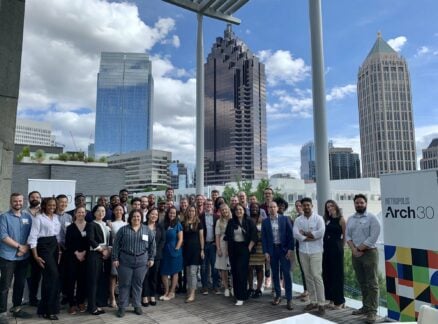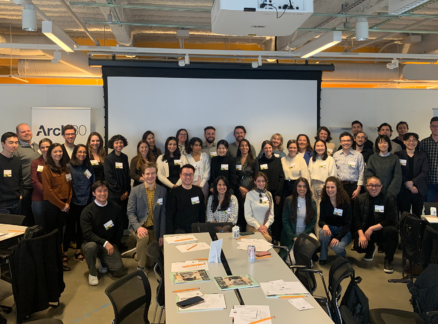November 1, 2010
The Ad-Hoc Work Space
Designers envision new solutions for the impromptu office.
As mobile technology shrinks in size but expands in power, it’s fair for us to ask: What constitutes a work space now? Is it a humble cubicle? A four-walled office with an actual door? A glassy building, slick and photo-ready? Raw, open space lined with computer monitors and glazed, attentive stares? The answer is all and none of the above. While traditional offices morph into something else—social spaces dedicated to human interaction—work increasingly happens elsewhere: in airports, on trains, at Starbucks, jammed four to a room in start-up mode. These awkward, ad-hoc spaces cry out for creative design solutions. So we invited Jonathan Olivares Design Research, Antenna Design, DEGW, and Scott Henderson to each create a setup for the impromptu office. Their concepts are likely to strike a chord with anyone who has ever sat on the floor at the departures gate with a laptop next to the lone electrical outlet.
AIRPORT
For busy travelers, working in airports is a necessary but unpleasant affair. Those without access to a business-class lounge face familiar and bleak scenarios: sitting on the floor plugged into the only unused power outlet in the terminal, trying to focus in an area bombarded with redundant announcements, loud conversations and the occasional crying child, or standing under the radiant logo of an overbranded gadget-charging table. Reviving the nearly extinct phone booth, we conceived of a work booth to accommodate busy travelers seeking privacy and concentration. Inside the booth, a small desk can host a generous amount of items, from a laptop to lunch, and a power hub sits at the rear. A curved and colored glass wall provides a high degree of visual and acoustic privacy while keeping users aware of the surrounding environment.
TRAIN
Considering how many people work on trains, we think a dedicated work car is easily warranted. We also believe that people would be willing to pay a little extra for a seat that was equipped for working and that they could reserve. Wi-Fi makes reservations possible with little effort, even on commuter trains. Through its appearance, our work car clearly announces its purpose, suggesting the appropriate behavior. It instills a sense of togetherness, as everyone is there for the same reason.
The car is created for a flexible and dynamic setting, echoing current trends in workplace design. Usually, train layouts are fixed (even ones that cater to business travelers, such as Amtrak’s Acela). They don’t fully provide individual privacy or offer the flexibility necessary for group meetings. We’ve addressed this with individual seats attached to tracks at the floor and ceiling. This allows the seats to be arranged individually or in clusters, and electricity can run to each seat through the ceiling track. All seats are still secure and within a designated zone, maintaining a clear passage through the car. The seats can be rotated so that passengers can face the traveling direction, the window, or a fellow passenger, giving them control over their own setup.
Each seat is a mobile workstation featuring a pivoting tray table with a cup holder, a power outlet, a storage tray, and a coat hanger. It also has adjustable blinders (winglike elements) that regulate privacy by moving the opening angle. A reading light is integrated into one of the blinders. For group arrangements, the blinders can be opened up to convey a “room.”
We think the work car would facilitate collaboration and social interaction and increase creativity and productivity. Colleagues who ride together can collaborate, people with shared professional interests can network, and those who need to accomplish focused work can retreat into the privacy of their seat, which provides a sense of comfort and aids concentration in a transient environment.
START-UP
With the influx of smart phones, laptops, and various wireless technologies, the future work space is centered on mobility. Workers increasingly want a place to work the way they want to, whether it’s racing to client presentations or having views of nature to help relieve their hurried pace. In the food industry, we’ve already seen a new wave of start-ups with the now ubiquitous food truck. Hyb(Rig) is a new start-up–workplace truck that provides a space for employees to work how they want to work with low overhead costs. It quickly brings companies where they need to be, in front of investors and clients. It can also transport them to remote locations for more concentrated work. When a start-up expands, it needs to do so rapidly. What better way than to have another work-space truck coupled with a conference truck? When the start-up is acquired by another company, all it has to do is drive over its workforce and equipment. When multiple groups need to brainstorm for several weeks or months, what better way than to convene the trucks? Mobile, flexible space will give the workforce new ways of working.
CAFÉ
People have meetings at Starbucks. They Skype, work on presentations, research, and conduct interviews there, bringing their iPads, smart phones, music players, and all of the cases that carry them. They do this not because the space was designed to make work and meetings easier but because of hot coffee and free Wi-Fi. With all of that computer gear on those tiny tables, however, it’s hard to find a spot to rest a steaming Venti Cinnamon Dolce Latte.
Taking advantage of ceiling space, Link-Lights has an extendable dock that accepts all varieties of smart phone—the smallest of the many gadgets routinely carried to Starbucks. Your personal phone initiates videoconferencing with anyone seated at a Link-Light in another Starbucks location. The call is enhanced by large rear-projection screens that look as good off as they do on, and premium audio so that the conference can be shared.
All of your phone’s apps can be watched in big-screen glory, giving the sports bar next door a new disruptive competitor. The Link-Light recognizes your Bluetooth-enabled gear, projecting your screen. It acts as a PC on its own, with all of the usual USB connectivity and other ports on its retracting arm. Optional floor messages in crisp projected light surround your Link-Light pod, alerting others that you’re busy (or telling them what game you’re watching), all the while liberating the table space for your coffee.





